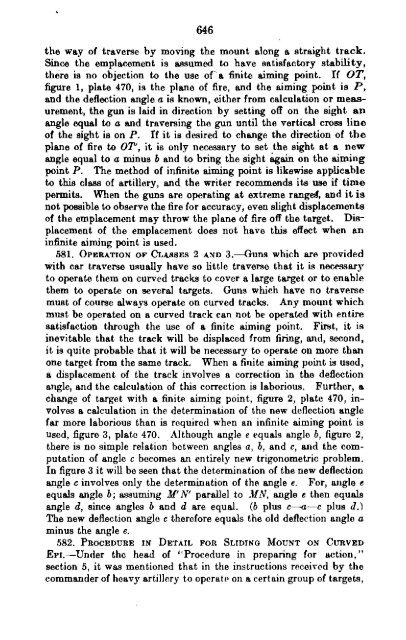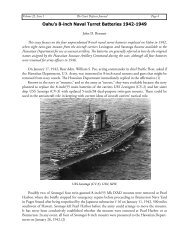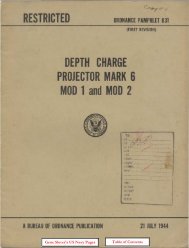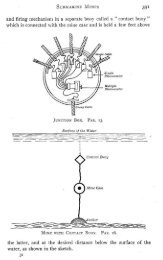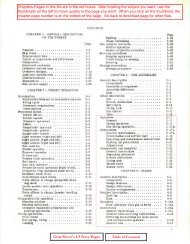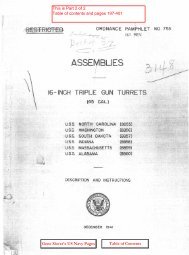...Railway artillery - Personal Page of GENE SLOVER
...Railway artillery - Personal Page of GENE SLOVER
...Railway artillery - Personal Page of GENE SLOVER
Create successful ePaper yourself
Turn your PDF publications into a flip-book with our unique Google optimized e-Paper software.
646<br />
the way <strong>of</strong> traverse by moving the mount along a straight track.<br />
Since the emplacement is assumed to have satisfactory stability,<br />
there is no objection to the use <strong>of</strong>' a finite aiming point. If OT,<br />
figure 1, plate 470, is the plane <strong>of</strong> fire, and the aiming point is P,<br />
and the deflection angle a is known, either from calculation or measurement,<br />
the gun is laid in direction by setting <strong>of</strong>f on the sight an<br />
angle equal to a and traversing the gun until the vertical cross line<br />
<strong>of</strong> the sight is on P. If it is desired to change the direction <strong>of</strong> the<br />
plane <strong>of</strong> fire to OIV, it is only necessary to set the sight at a new<br />
angle equal to a minus h and to bring the sight again on the aiming<br />
point P. The method <strong>of</strong> infinite aiming point is likewise applicable<br />
to this class <strong>of</strong> <strong>artillery</strong>, and the writer recommends its use if time<br />
permits. When the guns are operating at extreme rangelf, and it is<br />
not possible to observe the fire for accuracy, even slight displacements<br />
<strong>of</strong> the emplacement may throw the plane <strong>of</strong> fire <strong>of</strong>f the target. Displacement<br />
<strong>of</strong> the emplacement does not have this effect when an<br />
infinite aiming point is used.<br />
. 581. OPERATION OF CLASSES 2 AND 3.-Guns which are provided<br />
with car traverse usually have so little traverse that it is necessary<br />
to operate them on curved tracks to cover a large target or to enable<br />
them to operate on several targets. Guns which have no traverse<br />
must <strong>of</strong> course always operate on curved tracks. Any mount which<br />
must be operated on a curved track can not be operated with entire<br />
satisfaction through the use <strong>of</strong> a finite aiming point. First, it is<br />
inevitable that the track will be displaced from firing, and, second,<br />
it is quite probable that it will be necessary to operate on more than<br />
one target from the same track. When a finite aiming point is used,<br />
a displacement <strong>of</strong> the track involves a correction in the deflection<br />
angle, and the calculation <strong>of</strong> this correction is laborious. Further, a<br />
change <strong>of</strong> target with a finite aiming point, figure 2, plate 470, involves<br />
a calculation in the determination <strong>of</strong> the new deflection angle<br />
far more laborious than is required when an infinite aiming point is<br />
used, figure 3, plate 470. Although angle e equals angle h, figure 2,<br />
there is no simple relation' between angles a, h, and c, and the computation<br />
<strong>of</strong> angle c becomes an entirely new trigonometric problem.<br />
In figure 3 it will be seen that the determination <strong>of</strong> the new deflection<br />
angle c involves only the determination <strong>of</strong> the angle e. For, angle e<br />
equals angle hi assuming M' N' parallel to MN, angle e then equals<br />
angle d, since angles hand d are equal. (h plus c-o,-c plus d.)<br />
The new deflection angle c therefore equals the old deflection angle a<br />
minus the angle e.<br />
582. PROCEDURE IN DETAIL FOR SLIDING MOUNT ON CURVED<br />
EpI.-Under the head <strong>of</strong> "Procedure in preparing for action,"<br />
section 5, it was mentioned that in the instructions received by the<br />
commander <strong>of</strong> heavy <strong>artillery</strong> to operate on a certain group <strong>of</strong> targets,<br />
Digitized by Coogle


